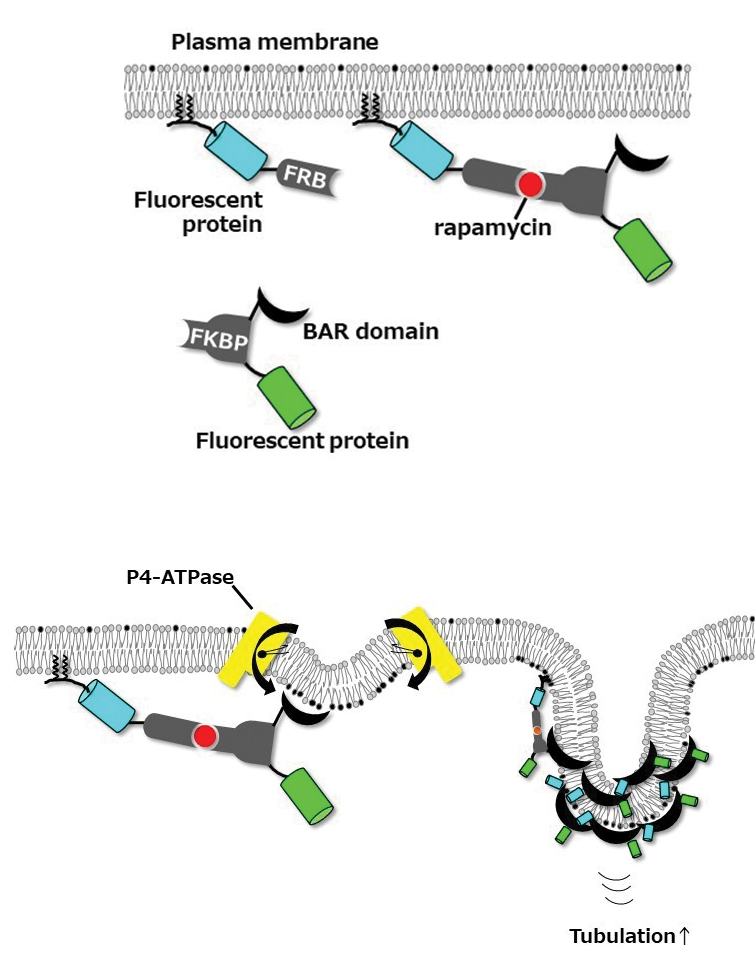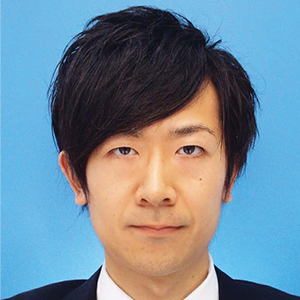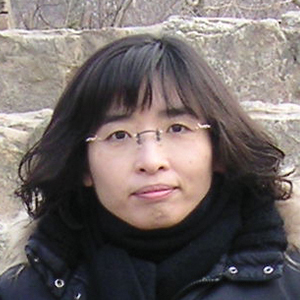Flipping lipids to deform membranes
Cell membranes change shape during such functions as membrane trafficking, cell migration and cell division. Rearrangement of cytoskeletons and interactions of various proteins, including membrane-bending proteins, regulate these changes. When the composition and asymmetric distribution of lipids between the two leaflets of the membrane bilayer change, membranes are deformed, a requirement for processes such as immune response and nutrient uptake.

In mammalian cells, the phospholipids phosphatidylserine and phosphatidylethanolamine are abundant in the cytoplasmic leaflet of the bilayer, whereas phosphatidylcholine, or PC, and sphingomyelin are abundant in the exoplasmic leaflet. P4-ATPases, also called flippases, catalyze unidirectional flipping of lipid molecules from the exoplasmic to the cytoplasmic leaflets of the bilayer and are crucial for membrane trafficking, but we don’t know how they are coupled to the process of vesicle formation.
P4-ATPase–mediated phospholipid translocation might cause an imbalance of lipid mass between the leaflets of the bilayer, so our lab wanted to find out whether the flipping enzymes of the P4-ATPase family contribute to changes in the shape of cell membranes. PC is abundant in the outer leaflet, so we hypothesized that greater PC-flipping activity causes an increase in lipid mass in the inner leaflet of the plasma membrane and induces inward membrane curvature.
To test this hypothesis, we used BIN/Amphiphysin/Rvs, or BAR, domains, which can sense membrane curvature and induce tubular membrane structures via self-oligomerization. We examined plasma membrane-bending caused by BAR domains with a rapamycin-inducible dimerization system, using FK506 binding proteins, or FKBPs, and FKBP–rapamycin binding domain, or FRB, proteins, that allow for acute recruitment of BAR domains to the plasma membrane. FRB was targeted to the plasma membrane by adding the N-terminal 11 amino acids of Lyn kinase, and FKBP was fused to the BAR domain.
When one specific BAR domain, called N-BAR, is recruited to the plasma membrane, we know that it penetrates the lipid bilayer via its N-terminal amphipathic helix, causing a small inward curve to form. The protein senses this change in curvature, leading to the recruitment of more N-BAR domains, which oligomerize along a part of the membrane and trigger transformation of the membrane into a tube.
Delta-N-BAR (which lacks the N-terminal amphipathic helix of the N-BAR domain) and F-BAR domains did not do this unless ATP10A was expressed exogenously in cells. In 2015, we had published in the Journal of Biological Chemistry our finding that ATP10A flipped PC from the outer to the inner leaflet of the plasma membrane, slightly changing the shape of the plasma membrane. Delta-N-BAR and F-BAR domains sensed the change and bound to the plasma membrane. The proteins then oligomerized along the membrane and transformed that part of the membrane into an inwardly protruding tubule.
Our recent study shows that changes in the transbilayer lipid compositions induced by P4-ATPase can deform biological membranes. Increased inward plasma membrane bending by ATP10A expression enhances endocytosis. The plasma membrane also changes shape during cell migration, cancer cell invasion, cell division, nutrient uptake and entry of pathogens into cells, so lipid-flipping activity may be involved in any or all of these processes.
Enjoy reading ASBMB Today?
Become a member to receive the print edition four times a year and the digital edition monthly.
Learn moreGet the latest from ASBMB Today
Enter your email address, and we’ll send you a weekly email with recent articles, interviews and more.
Latest in Science
Science highlights or most popular articles

The science of staying strong
Muscles power every movement, but they also tell the story of aging itself. Scientists are uncovering how strength fades, why some species resist it and what lifestyle and molecular clues could help preserve muscle health for life.

Bacteriophage protein could make queso fresco safer
Researchers characterized the structure and function of PlyP100, a bacteriophage protein that shows promise as a food-safe antimicrobial for preventing Listeria monocytogenes growth in fresh cheeses.

Building the blueprint to block HIV
Wesley Sundquist will present his work on the HIV capsid and revolutionary drug, Lenacapavir, at the ASBMB Annual Meeting, March 7–10, in Maryland.

Gut microbes hijack cancer pathway in high-fat diets
Researchers at the Feinstein Institutes for Medical Research found that a high-fat diet increases ammonia-producing bacteria in the gut microbiome of mice, which in turn disrupts TGF-β signaling and promotes colorectal cancer.

Mapping fentanyl’s cellular footprint
Using a new imaging method, researchers at State University of New York at Buffalo traced fentanyl’s effects inside brain immune cells, revealing how the drug alters lipid droplets, pointing to new paths for addiction diagnostics.

Designing life’s building blocks with AI
Tanja Kortemme, a professor at the University of California, San Francisco, will discuss her research using computational biology to engineer proteins at the 2026 ASBMB Annual Meeting.



